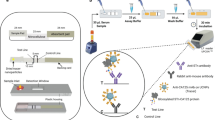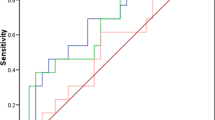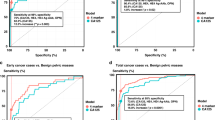Abstract
Cancer antigen 125 (CA125) is a coelomic epithelium-related antigen carried by a high molecular weight glycoprotein complex. It is commonly used as a tumor marker for ovarian cancer to monitor disease progression and response to therapy and as an early detection for recurrence after treatment. The aim of this study was to test the reliability of two different assay methods, a radioimmunometric assay (RIA) and an automated chemiluminescent enzyme immunoassay (CLEIA) system, by measuring CA125 serum levels using both methods in 357 patients and comparing the results. Patients were recruited from Oncologic Unit A, Policlinico Umberto I, Roma. Eighty-six were healthy donors, while 271 were oncologic patients representing a variety of diagnoses. Within this group, 76 patients were diagnosed with an ovarian related pathology (28 cancerous and 48 benign). The evaluation of CA125 marker blood levels showed a high agreement in healthy donors group (R 2 = 0.9003). Interesting results emerged when sera collected from oncologic patients were assessed: significant differences between the two assays were found in nine samples. When assayed again with RIA after a dilution, new values agreed with undiluted CLEIA values (R 2 = 0.9847). Our data suggest an overall good comparison between the two methods. However, some artifacts were obtained with RIA and indicate an underlying presence of “hook effect”. CLEIA automated assay showed a good reliability and should be preferred to one-step radioimmunoassays in order to minimize errors.






Similar content being viewed by others
References
Sturgeon C. Practice guidelines for tumor marker use in the clinic. Clin Chem. 2002;48:1151–9.
Duffy MJ. Tumor markers in clinical practice: a review focusing on common solid cancers. Med Princ Pract. 2012. doi:10.1159/000338393.
Kilpatrick ES, Lind MJ. Appropriate requesting of serum tumour markers. BMJ. 2009;339:b3111.
Suh KS, Park SW, Castro A, Patel H, Blake P, Liang M, et al. Ovarian cancer biomarkers for molecular biosensors and translational medicine. Expert Rev Mol Diagn. 2010;10(8):1069–83.
Yin BW, Lloyd KO. Molecular cloning of the CA125 ovarian cancer antigen: identification as a new mucin, MUC16. J J Biol Chem. 2001;276(29):27371–5.
Yin BW, Dnistrian A, Lloyd KO. Ovarian cancer antigen CA125 is encoded by the MUC16 mucin gene. Int J Cancer. 2002;98(5):737–40.
Bischof P. What do we know about the origin of CA 125? Eur J Obstet Gynecol Reprod Biol. 1993;49:93–8.
Kabawat SE, Bast Jr RC, Bhan AK, et al. Tissue distribution of a coelomic-epithelium-related antigen recognized by the monoclonal antibody OC125. Int J Gynecol Pathol. 1983;2:275–85.
Walker PL, Crook M. Tumour marker requesting in primary care and the role of the laboratory. J Clin Pathol. 2011;64(5):443–6.
Bast RC, Klug TL, John St E, Jenison E, Niloff JM, Lazarus H, et al. A radioimmunoassay using a monoclonal antibody to monitor the course of epithelial ovarian cancer. N Engl J Med. 1983;309(15):883–7.
Pignata S, et al. Follow-up with CA125 after primary therapy of advanced ovarian cancer: in favor of continuing to prescribe CA125 during follow-up. Ann Oncol. 2011;22(8):viii40–4.
Santillan A, Garg R, Zahurak ML, Gardner GJ, Giuntoli RL, Armstrong DK, et al. Risk of epithelial ovarian cancer recurrence in patients with rising serum CA-125 levels within the normal range. J Clin Oncol. 2005;23(36):9338–43.
Granato T, Midulla C, Longo F, Colaprisca B, Frati L, Anastasi E. Role of HE4, CA72.4, and CA125 in monitoring ovarian cancer. Tumor Biol. 2012. doi:10.1007/s13277-012-0381-8.
Bast RC, Xu FJ, Yu YH, Barnhill S, Zhang Z, Mills GB. CA 125: the past and the future. Int J Biol Mark. 1998;13(4):179–87.
Midulla C, Manganaro L, Longo F, Viggiani V, Frati L, Granato T, et al. HE4 combined with MDCT imaging is a good marker in the evaluation of disease extension in advanced epithelial ovarian carcinoma. Tumour Bio. 2012;33(5):1291–8.
Anastasi E, Granato T, Coppa A, Manganaro L, Giannini G, Comploj S, et al. HE4 in the differential diagnosis of a pelvic mass: a case report. Int J Mol Sci. 2011;12(1):627–32.
Singhal A, et al. Elevation of CA 125 and CA 19-9 in patients with end-stage liver disease. Int J Biol Mark. 2012;27(2):e147–51.
Duffy MJ, Bonfrer JM, et al. CA125 in ovarian cancer: European Group on Tumor Markers guidelines for clinical use. Int J Gynecol Cancer. 2005;15(5):679–91.
Anthony AM, Ermens AAM, van Duijnhove HLP, et al. Dilution protocols for detection of hook effects/prozone phenomenon. Clin Chem. 2000;46(10):1719–20.
McShane LM, et al. REporting recommendations for tumour MARKer prognostic studies (REMARK). Br J Cancer. 2005;93(4):387–91.
Osman N, et al. Correlation of serum CA125 with stage, grade and survival of patients with epithelial ovarian cancer at a single centre. Ir Med J. 2008;101(8):245–7.
Hayes Daniel F, et al. A bad tumor marker is as bad as a bad drug: applying scientific principles to tumor biomarker research. Am Assoc Cancer Res Educ Book. 2012;2012(1):139–41.
Colman PG, Di Mario U, Rabizadeh A, Dotta F, Anastasi E, Eisenbarth GS. A prozone phenomenon interferes in islet cell antibody detection: direct comparison of two methods in subjects at risk of diabetes and in insulin dependent diabetics at onset. J Autoimmun. 1988;1(2):109–17.
Wu JT. Diagnosis and management of cancer using serologic tumor markers. In: Henry JB, editor. Clinical diagnosis and management by laboratory methods. 19th ed. Philadelphia: WB Saunders; 1996. p. 1071.
Pesce MA. “High-dose hook effect” with the Centocar CA 125 assay. Clin Chem. 1993;39:1347.
Barbati A, Di Renzo GC, Cosmi EV. Hook effect in immunoradiometric assay of CA 125 in peritoneal fluid: evidence of high CA 125 concentrations by a comparative immunoblotting analysis. Clin Chem. 1993;39(7):1548–9.
Acknowledgments
This study is founded by The University of Rome “Sapienza”. We are thankful to Giuseppina Gennarini, Barbara Colaprisca, Silvestra Tudini, and Pasqualina Moro for their technical assistance.
Conflicts of interest
None.
Author information
Authors and Affiliations
Corresponding author
Rights and permissions
About this article
Cite this article
Falzarano, R., Viggiani, V., Michienzi, S. et al. CLEIA CA125 evidences: good analytical performance avoiding “Hook effect”. Tumor Biol. 34, 387–393 (2013). https://doi.org/10.1007/s13277-012-0561-6
Received:
Accepted:
Published:
Issue Date:
DOI: https://doi.org/10.1007/s13277-012-0561-6




